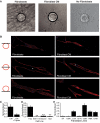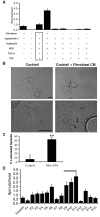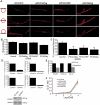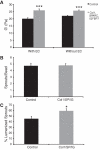The requirement for fibroblasts in angiogenesis: fibroblast-derived matrix proteins are essential for endothelial cell lumen formation
- PMID: 21865599
- PMCID: PMC3192859
- DOI: 10.1091/mbc.E11-05-0393
The requirement for fibroblasts in angiogenesis: fibroblast-derived matrix proteins are essential for endothelial cell lumen formation
Abstract
A role for fibroblasts in physiological and pathological angiogenesis is now well recognized; however, the precise mechanisms underlying their action have not been determined. Using an in vitro angiogenesis model in combination with a candidate gene approach, column chromatography, and mass spectrometry, we identify two classes of fibroblast-derived factors--one that supports vessel sprouting but not lumen formation, and one that promotes lumen formation. In the absence of fibroblasts a combination of angiopoietin-1, angiogenin, hepatocyte growth factor, transforming growth factor-α, and tumor necrosis factor drives robust endothelial cell (EC) sprouting; however, lumens fail to form. Subsequent addition of fibroblast-conditioned medium restores lumenogenesis. Using small interfering RNA-mediated knockdown, we show that five genes expressed in fibroblasts--collagen I, procollagen C endopeptidase enhancer 1, secreted protein acidic and rich in cysteine, transforming growth factor-β-induced protein ig-h3, and insulin growth factor-binding protein 7--are necessary for lumen formation. Moreover, lumen formation can be rescued by addition of purified protein to knockdown cultures. Finally, using rheology, we demonstrate that the presence of these matricellular proteins results in significantly stiffer gels, which correlates with enhanced lumen formation. These findings highlight the critical role that fibroblast-derived extracellular matrix components play in EC lumen formation and provide potential insight into the role of fibroblasts in the tumor microenvironment.
Figures





Similar articles
-
Analysis of stromal cell secretomes reveals a critical role for stromal cell-derived hepatocyte growth factor and fibronectin in angiogenesis.Arterioscler Thromb Vasc Biol. 2013 Mar;33(3):513-22. doi: 10.1161/ATVBAHA.112.300782. Epub 2013 Jan 3. Arterioscler Thromb Vasc Biol. 2013. PMID: 23288153 Free PMC article.
-
Normal human fibroblasts enable melanoma cells to induce angiogenesis in type I collagen.Surgery. 2005 Sep;138(3):439-49. doi: 10.1016/j.surg.2005.06.031. Surgery. 2005. PMID: 16213896
-
Vasohibin 2 is transcriptionally activated and promotes angiogenesis in hepatocellular carcinoma.Oncogene. 2013 Mar 28;32(13):1724-34. doi: 10.1038/onc.2012.177. Epub 2012 May 21. Oncogene. 2013. PMID: 22614011
-
Targeting tumor micro-environment for design and development of novel anti-angiogenic agents arresting tumor growth.Prog Biophys Mol Biol. 2013 Nov;113(2):333-54. doi: 10.1016/j.pbiomolbio.2013.10.001. Epub 2013 Oct 15. Prog Biophys Mol Biol. 2013. PMID: 24139944 Review.
-
Extracellular matrix-derived peptides in tissue remodeling and fibrosis.Matrix Biol. 2020 Sep;91-92:176-187. doi: 10.1016/j.matbio.2020.04.006. Epub 2020 May 8. Matrix Biol. 2020. PMID: 32438055 Free PMC article. Review.
Cited by
-
Integrating Additive Manufacturing Techniques to Improve Cell-Based Implants for the Treatment of Type 1 Diabetes.Adv Healthc Mater. 2022 Jul;11(13):e2200243. doi: 10.1002/adhm.202200243. Epub 2022 Apr 22. Adv Healthc Mater. 2022. PMID: 35412030 Free PMC article. Review.
-
3D Cell Models in Radiobiology: Improving the Predictive Value of In Vitro Research.Int J Mol Sci. 2023 Jun 25;24(13):10620. doi: 10.3390/ijms241310620. Int J Mol Sci. 2023. PMID: 37445795 Free PMC article. Review.
-
Emerging roles for CNS fibroblasts in health, injury and disease.Nat Rev Neurosci. 2022 Jan;23(1):23-34. doi: 10.1038/s41583-021-00525-w. Epub 2021 Oct 20. Nat Rev Neurosci. 2022. PMID: 34671105 Free PMC article. Review.
-
Aspiration-assisted bioprinting for precise positioning of biologics.Sci Adv. 2020 Mar 6;6(10):eaaw5111. doi: 10.1126/sciadv.aaw5111. eCollection 2020 Mar. Sci Adv. 2020. PMID: 32181332 Free PMC article.
-
Mechanical strain controls endothelial patterning during angiogenic sprouting.Cell Mol Bioeng. 2012 Dec 1;5(4):463-473. doi: 10.1007/s12195-012-0242-y. Cell Mol Bioeng. 2012. PMID: 24015155 Free PMC article.
References
-
- Aitkenhead M, Wang SJ, Nakatsu MN, Mestas J, Heard C, Hughes CC. Identification of endothelial cell genes expressed in an in vitro model of angiogenesis: induction of ESM-1, (beta)ig-h3, and NrCAM. Microvasc Res. 2002;63:159–171. - PubMed
-
- Albini A, Magnani E, Noonan DM. The tumor microenvironment: biology of a complex cellular and tissue society. Q J Nucl Med Mol Imaging. 2010;54:244–248. - PubMed
-
- Berthod F, Germain L, Tremblay N, Auger FA. Extracellular matrix deposition by fibroblasts is necessary to promote capillary-like tube formation in vitro. J Cell Physiol. 2006;207:491–498. - PubMed
Publication types
MeSH terms
Substances
Grants and funding
LinkOut - more resources
Full Text Sources
Other Literature Sources
Molecular Biology Databases
Miscellaneous

